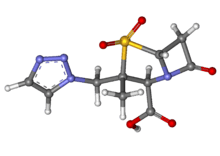Tazobactam
Not to be confused with Teixobactin.
 | |
 | |
| Clinical data | |
|---|---|
| AHFS/Drugs.com | International Drug Names |
| Pregnancy category |
|
| Routes of administration | Intravenous |
| ATC code | J01CG02 (WHO) |
| Legal status | |
| Legal status |
|
| Identifiers | |
| |
| CAS Number |
89786-04-9 |
| PubChem (CID) | 123630 |
| DrugBank |
DB01606 |
| ChemSpider |
110216 |
| UNII |
SE10G96M8W |
| KEGG |
D00660 |
| ChEBI |
CHEBI:9421 |
| ChEMBL |
CHEMBL404 |
| ECHA InfoCard | 100.108.321 |
| Chemical and physical data | |
| Formula | C10H12N4O5S |
| Molar mass | 300.289 g/mol |
| 3D model (Jmol) | Interactive image |
| |
| |
| | |
Tazobactam is a pharmaceutical drug that inhibits the action of bacterial β-lactamases, especially those belonging to the SHV-1 and TEM groups. It is commonly used as its sodium salt, tazobactam sodium.
Tazobactam is combined with the extended spectrum β-lactam antibiotic piperacillin in the drug piperacillin/tazobactam, used in infections due Pseudomonas aeruginosa. Tazobactam broadens the spectrum of piperacillin by making it effective against organisms that express β-lactamase and would normally degrade piperacillin.[1]
Tazobactam is a heavily modified penicillin and a sulfone.
See also
References
- ↑ Yang Y, Rasmussen BA, Shlaes DM (1999). "Class A beta-lactamases—enzyme-inhibitor interactions and resistance". Pharmacol Ther. 83: 141–151. doi:10.1016/S0163-7258(99)00027-3.
This article is issued from Wikipedia - version of the 10/14/2016. The text is available under the Creative Commons Attribution/Share Alike but additional terms may apply for the media files.